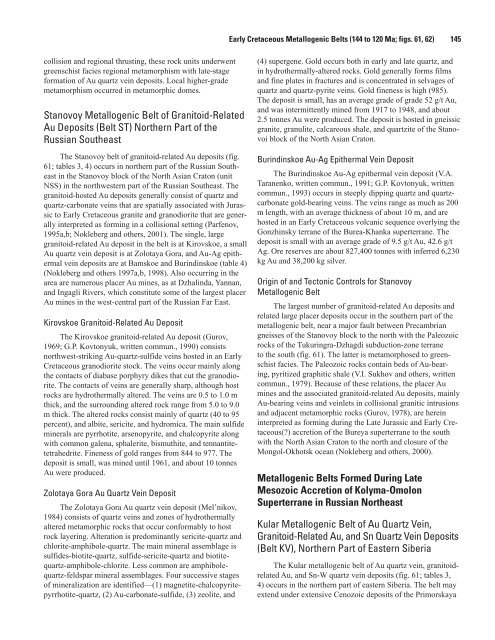USGS Professional Paper 1697 - Alaska Resources Library
USGS Professional Paper 1697 - Alaska Resources Library
USGS Professional Paper 1697 - Alaska Resources Library
Create successful ePaper yourself
Turn your PDF publications into a flip-book with our unique Google optimized e-Paper software.
collision and regional thrusting, these rock units underwent<br />
greenschist facies regional metamorphism with late-stage<br />
formation of Au quartz vein deposits. Local higher-grade<br />
metamorphism occurred in metamorphic domes.<br />
Stanovoy Metallogenic Belt of Granitoid-Related<br />
Au Deposits (Belt ST) Northern Part of the<br />
Russian Southeast<br />
The Stanovoy belt of granitoid-related Au deposits (fig.<br />
61; tables 3, 4) occurs in northern part of the Russian Southeast<br />
in the Stanovoy block of the North Asian Craton (unit<br />
NSS) in the northwestern part of the Russian Southeast. The<br />
granitoid-hosted Au deposits generally consist of quartz and<br />
quartz-carbonate veins that are spatially associated with Jurassic<br />
to Early Cretaceous granite and granodiorite that are generally<br />
interpreted as forming in a collisional setting (Parfenov,<br />
1995a,b; Nokleberg and others, 2001). The single, large<br />
granitoid-related Au deposit in the belt is at Kirovskoe, a small<br />
Au quartz vein deposit is at Zolotaya Gora, and Au-Ag epithermal<br />
vein deposits are at Bamskoe and Burindinskoe (table 4)<br />
(Nokleberg and others 1997a,b, 1998). Also occurring in the<br />
area are numerous placer Au mines, as at Dzhalinda, Yannan,<br />
and Ingagli Rivers, which constitute some of the largest placer<br />
Au mines in the west-central part of the Russian Far East.<br />
Kirovskoe Granitoid-Related Au Deposit<br />
The Kirovskoe granitoid-related Au deposit (Gurov,<br />
1969; G.P. Kovtonyuk, written commun., 1990) consists<br />
northwest-striking Au-quartz-sulfide veins hosted in an Early<br />
Cretaceous granodiorite stock. The veins occur mainly along<br />
the contacts of diabase porphyry dikes that cut the granodiorite.<br />
The contacts of veins are generally sharp, although host<br />
rocks are hydrothermally altered. The veins are 0.5 to 1.0 m<br />
thick, and the surrounding altered rock range from 5.0 to 9.0<br />
m thick. The altered rocks consist mainly of quartz (40 to 95<br />
percent), and albite, sericite, and hydromica. The main sulfide<br />
minerals are pyrrhotite, arsenopyrite, and chalcopyrite along<br />
with common galena, sphalerite, bismuthite, and tennantitetetrahedrite.<br />
Fineness of gold ranges from 844 to 977. The<br />
deposit is small, was mined until 1961, and about 10 tonnes<br />
Au were produced.<br />
Zolotaya Gora Au Quartz Vein Deposit<br />
The Zolotaya Gora Au quartz vein deposit (Mel’nikov,<br />
1984) consists of quartz veins and zones of hydrothermally<br />
altered metamorphic rocks that occur conformably to host<br />
rock layering. Alteration is predominantly sericite-quartz and<br />
chlorite-amphibole-quartz. The main mineral assemblage is<br />
sulfides-biotite-quartz, sulfide-sericite-quartz and biotitequartz-amphibole-chlorite.<br />
Less common are amphibolequartz-feldspar<br />
mineral assemblages. Four successive stages<br />
of mineralization are identified—(1) magnetite-chalcopyritepyrrhotite-quartz,<br />
(2) Au-carbonate-sulfide, (3) zeolite, and<br />
Early Cretaceous Metallogenic Belts (144 to 120 Ma; figs. 61, 62) 145<br />
(4) supergene. Gold occurs both in early and late quartz, and<br />
in hydrothermally-altered rocks. Gold generally forms films<br />
and fine plates in fractures and is concentrated in selvages of<br />
quartz and quartz-pyrite veins. Gold fineness is high (985).<br />
The deposit is small, has an average grade of grade 52 g/t Au,<br />
and was intermittently mined from 1917 to 1948, and about<br />
2.5 tonnes Au were produced. The deposit is hosted in gneissic<br />
granite, granulite, calcareous shale, and quartzite of the Stanovoi<br />
block of the North Asian Craton.<br />
Burindinskoe Au-Ag Epithermal Vein Deposit<br />
The Burindinskoe Au-Ag epithermal vein deposit (V.A.<br />
Taranenko, written commun., 1991; G.P. Kovtonyuk, written<br />
commun., 1993) occurs in steeply dipping quartz and quartzcarbonate<br />
gold-bearing veins. The veins range as much as 200<br />
m length, with an average thickness of about 10 m, and are<br />
hosted in an Early Cretaceous volcanic sequence overlying the<br />
Gonzhinsky terrane of the Burea-Khanka superterrane. The<br />
deposit is small with an average grade of 9.5 g/t Au, 42.6 g/t<br />
Ag. Ore reserves are about 827,400 tonnes with inferred 6,230<br />
kg Au and 38,200 kg silver.<br />
Origin of and Tectonic Controls for Stanovoy<br />
Metallogenic Belt<br />
The largest number of granitoid-related Au deposits and<br />
related large placer deposits occur in the southern part of the<br />
metallogenic belt, near a major fault between Precambrian<br />
gneisses of the Stanovoy block to the north with the Paleozoic<br />
rocks of the Tukuringra-Dzhagdi subduction-zone terrane<br />
to the south (fig. 61). The latter is metamorphosed to greenschist<br />
facies. The Paleozoic rocks contain beds of Au-bearing,<br />
pyritized graphitic shale (V.I. Sukhov and others, written<br />
commun., 1979). Because of these relations, the placer Au<br />
mines and the associated granitoid-related Au deposits, mainly<br />
Au-bearing veins and veinlets in collisional granitic intrusions<br />
and adjacent metamorphic rocks (Gurov, 1978), are herein<br />
interpreted as forming during the Late Jurassic and Early Cretaceous(?)<br />
accretion of the Bureya superterrane to the south<br />
with the North Asian Craton to the north and closure of the<br />
Mongol-Okhotsk ocean (Nokleberg and others, 2000).<br />
Metallogenic Belts Formed During Late<br />
Mesozoic Accretion of Kolyma-Omolon<br />
Superterrane in Russian Northeast<br />
Kular Metallogenic Belt of Au Quartz Vein,<br />
Granitoid-Related Au, and Sn Quartz Vein Deposits<br />
(Belt KV), Northern Part of Eastern Siberia<br />
The Kular metallogenic belt of Au quartz vein, granitoidrelated<br />
Au, and Sn-W quartz vein deposits (fig. 61; tables 3,<br />
4) occurs in the northern part of eastern Siberia. The belt may<br />
extend under extensive Cenozoic deposits of the Primorskaya
















